Sustainability in the procurement of cloud services
As a consultant with many years of experience in public procurement processes and a strong commitment to sustainability, I wrote a thesis on the procurement of sustainable cloud services as part of the CAS 'Public Procurement'. The aim of the thesis was to develop a blueprint that provides transparent methods and customizable criteria for the procurement of sustainable cloud services. In this blog post, I am happy to share these findings with a wider audience, especially procurement officers, to raise awareness and competence for sustainable procurement.
Why sustainable cloud services?
The question of why the procurement of sustainable cloud services is of increasing interest can be easily recognized by the following three factors: Firstly, the global aggregated energy and other resource consumption of data centers is recording a steady increase. At the same time, the absolute volume and market share of cloud-based services is growing continuously. In addition, awareness of sustainability issues and sustainable procurement in particular is increasing, as shown by the very prominent position in revised public procurement laws (BöB/IVöB): Sustainability is mentioned there as the first bullet point in Art. 2 "Purpose". The procurement of sustainable cloud services is therefore at the heart of all these trends.
What is sustainability?
Sustainability is a holistic concept that aims to meet the needs of the current generation without compromising the opportunities of future generations and encompasses environmental, economic and social dimensions, as we described in our blog Is sustainable IT procurement always more expensive?
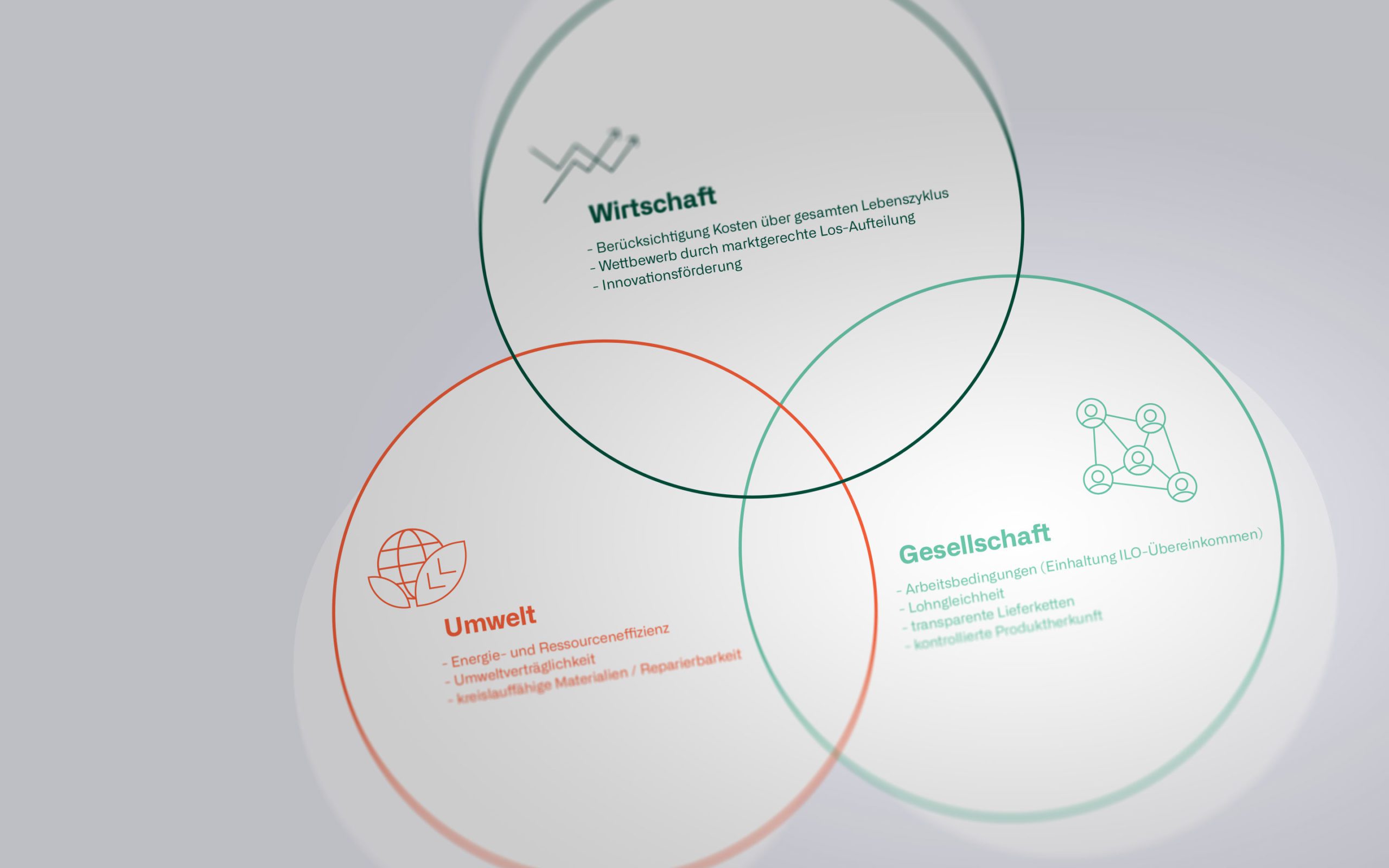
Blog
Is sustainable IT procurement always more expensive?
by Rüdiger Vietzem & Christian Klein
What has been incorporated into the Blueprint?
Various standards, guidelines and findings were incorporated into the creation of the blueprint for my CAS work, such as the FOEN's relevance matrix[1], the Federal Chancellery's resource and environmental standards[2] and SECO's social guidelines[3]. In addition, search results from various tendering platforms, results of a broader web search and, last but not least, experience from our own procurement projects were taken into account.
What is the method?
In the individual case of a cloud service procurement, we follow a structured process consisting of various phases. First, a thorough needs analysis is carried out, in which the requirements and objectives of the procurement office are identified. This is followed by an analysis of which type of cloud provider and which services are actually required (from the individual SaaS-based application to the hyperscaler); last but not least, legal and security-related aspects are also taken into account. A market study is also essential in this procurement context. Based on these analyses, criteria are developed and elaborated, validated and fine-tuned. This structured approach is an integral part of the atrete procurement methodology, which is continuously maintained and applied.
In addition to the analyses described above, further questions should be answered: Do the criteria fit the procurement object and type of cloud provider, are the three sustainability aspects (social, economic and ecological) taken into account, and is the number of criteria manageable and manageable? Are the criteria verifiable? We also recommend critically scrutinizing the respective types of criteria (must, should) and the weighting, as well as selecting suitable types of evidence such as self-declarations, certificates or explanations.
We can simplify this process with the results we have obtained, as we have developed two sets of criteria as a "basic set" for quick and easy handling: The basic criteria, which can basically be applied to every cloud provider submission and only require minimal adjustments, and the extended criteria set, which contains additional criteria that meet the specific characteristics of the procurement project.
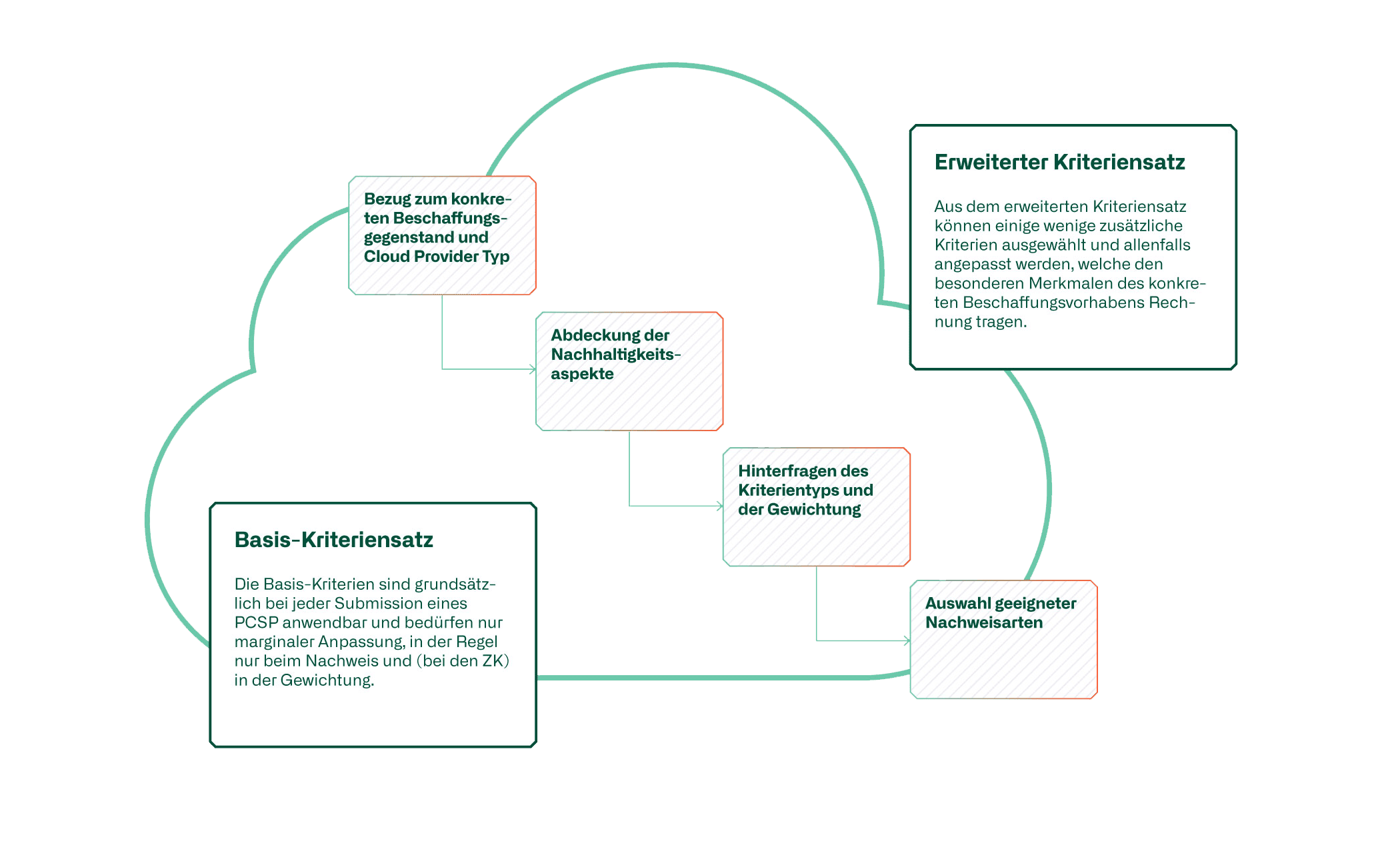
Example criteria
Below we show four examples from our set of around 25 sustainability criteria for cloud services.
| Topic | Designation | Brief description |
| Environment | Environmental management system in accordance with ISO 14001 | The tendered cloud provider has implemented an environmental management system in accordance with ISO 14001. The tendered cloud provider can provide evidence of corresponding certification. Alternatively: The tendered cloud provider can at least provide evidence that it has documented corresponding processes and actually implements them operationally. |
| Environment | Sustainability tools | The tendered cloud provider provides sustainability tools and supports the client with data, instruments and technical expertise to promote sustainability. These can be, for example, tools for determining the customer's carbon footprint in the cloud or exchange platforms for sustainability data. The existence, number and scope of content, as well as the quality and informative value of the documentation of such tools are evaluated. |
| Environment | Reference projects with customers | The advertised cloud provider supports or participates in exemplary sustainability projects. These may have been carried out together with, on behalf of or at customers, for example energy efficiency projects or cooperation with renewable energy projects. The existence of reference projects, their number and scope, as well as the quality and informative value of their documentation will be assessed. |
| Environment and/or social issues | Supply Chain Management | The tendered cloud provider has an established supply chain management system that also requires its suppliers to comply with environmental and social standards. The tendered cloud provider can provide evidence of appropriate certification or a report by an independent auditor, which shows that it also requires its suppliers to comply with environmental and social standards. Alternatively: The tendered cloud provider can at least provide evidence of the existence of corresponding documented internal processes and demonstrable results. |
We will continue this blog in a second part. The focus of the second part will be on explaining further examples, where we will also go into more detail about the type of criteria, the recommended number of criteria and the coverage of the three sustainability dimensions.
What experiences have you had with regard to the procurement of sustainable cloud services?
We look forward to your feedback and a lively exchange.
We put our many years of consulting experience in public and private procurement to profitable use for your individual sourcing projects. With our support, your image and your budget can ultimately benefit as well as the environment and society.
[1] https://www.bafu.admin.ch/bafu/de/home/themen/wirtschaft-konsum/fachinformationen/oekologische-oeffentliche-beschaffung/relevanzmatrix.html
[2] https://www.bk.admin.ch/bk/de/home/digitale-transformation-ikt-lenkung/ikt-vorgaben/prozesse-methoden/p025_ressourcen_und_umweltstandard_fuer_die_beschaffung_der_ikt-infrastruktur.html
[3] https://www.bkb.admin.ch/dam/bkb/de/dokumente/Oeffentliches_Beschaffungswesen/Nachhaltige_Beschaffung/Empfehlung_Nachhaltige%20Beschaffung_BKB_de_Neu.pdf.download.pdf/Empfehlung_Nachhaltige%20Beschaffung_BKB_de_Neu.pdf
No Bid
No offers received in response to the invitation to tender in the private-law (RfP) or public-law (Submission) environment? This is not only disappointing, but usually means lost time and additional costs. In extreme cases, it can even completely disrupt a critical project.
Case study
HiTect is a construction supplier with around 80 employees at two Swiss locations and would like to completely outsource its IT operations. Corresponding RfP documents were carefully and extensively prepared and checked for "marketability". Nevertheless, no offers have been received. The CEO is surprised and asks himself "where did we go wrong?
What is the reason?
The reasons for the "no bid" must be analyzed on a case-by-case basis. Typically, however, one or more of the following aspects are overlooked when conducting an RfP or submission process:
- The market for IT services currently tends to be determined by the providers: These do not have to accept contracts with too many compromises - on the contrary: providers have a feeling for "attractive" tenders, namely those which ideally offer long-term contracts, prestige and deployment opportunities for their core competencies.
- The preparation of a bid costs bidding companies a great deal of time and resources, for example in studying the documents, preparing the bid, and internal review processes. On the other hand, it is often uncertain whether all this is worthwhile - because there is usually only one winner who is awarded the contract.
- The situation is similar when suppliers cannot estimate the contract volume awarded, or can only do so with difficulty, for example if no or only low binding minimum sales or only reference quantities were put out to tender. The effort for a bid must be worthwhile, at least the chances must be right.
- The subject matter of the procurement is described in a (possibly unnecessarily) rigid manner and restricts the providers in their choice of solution methods, so that they cannot optimally offer their core competencies and preferred solutions. In the worst case, the procurement object is specified in a very detailed form, which is no longer up-to-date or misses the market.
What can you do at the RfP?
Fortunately, in the private law environment, it is possible to at least partially eliminate these causes, thereby significantly reducing the risk of a "no bid." Some measures are listed below:
- Make RfP documents manageable and readable: The time until the basic decision ("to offer or not?") must be short, offers should not fill federal folders.
- Focus on the "what" rather than the "how." The need must emerge from the RfP documents. For the choice of solution, the providers should be given as much freedom and flexibility as possible in terms of implementation variants. A balance is required here between flexibility and simultaneous comparability of the offers.
- Inform early and get feedback through an RfI: Communicate the most important information and ask key questions to the market. This can save you some surprises.
- Create transparency: Communicate the selection process (see graphic below this section) and make it clear that you would rather have three suitable offers than ten random offers. The smaller the group of competitors, the higher the perceived chance of the individual provider.
- Involvement of potential providers: Use Q&A to incorporate opportunities for improvement and other ideas. Encourage providers to contribute suggestions.
- Courage to be "agile": If the results (e.g., number of vendors still "in the running") are different than expected, a change of plan is also legitimate. Invest time and resources to repeat one or more steps in the "selection funnel" shown below.
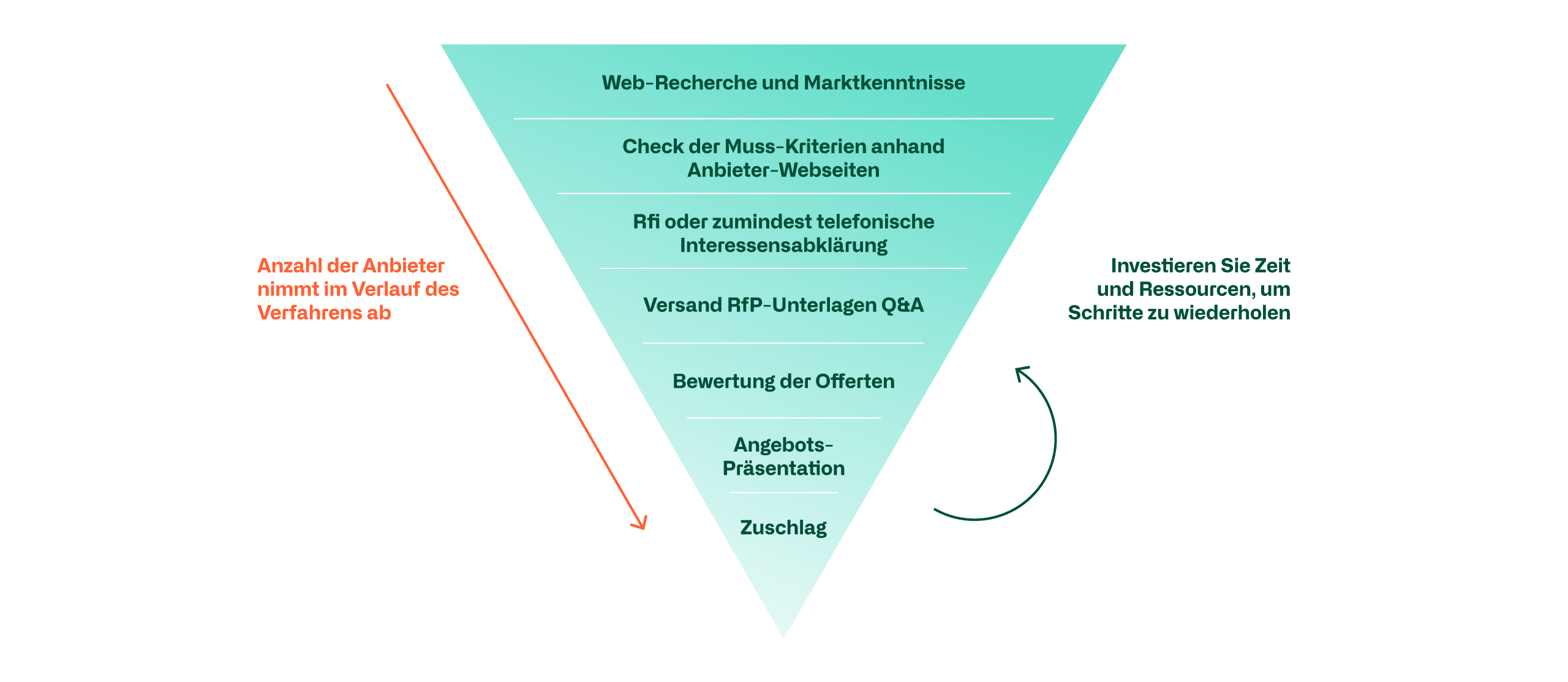
What can you do in case of a submission?
Additional rules and restrictions must be observed for procurement projects under public law.
- Submissions are more binding. Changes of contents and processes are only possible to a limited extent. Some is possible via "corrections" in simap.
- Comparability of offers: This is not only about fairness and correctness, but the evaluations must be documented in a comprehensible way and be robust against complaints.
- Uncertainty as to who will offer everything: The selection of suppliers is not made by the procurement agency, but by the market. This requires special foresight and a good understanding of the market.
- The limited communication between the procurement agency and the suppliers makes informal exchanges difficult in general, and clarifications after the deadline of the supplier questions in particular. In the case of complex procurement objects, a dialogue procedure can be carried out at best. Basically, there are two ways to deal with this: Anticipate as many questions as possible and specify them in detail - or give a lot of leeway. Incidentally, an RfI is also possible for public procurements - via simap "advance notice".

Tip
Consult an experienced consulting firm like atrete for support!
More about IT procurement with atrete
...and if it has already happened - i.e. if no offer has been received?
If no offer is received after the offer deadline, there are several options.
- In any case, the reasons for the respective rejection should be determined. Providers will have a vested interest in revealing these. This is because any feedback from their side can be incorporated into a revised RfP, which may then be attractive enough for an offer.
- An internal "lessons learned" event should be held and the RfP documents adapted accordingly - both in terms of requirements and methodologically and in terms of scope. With these revised documents, in which the providers recognize their own input, a second tender round can then be carried out, if necessary with additional providers.
There is less flexibility in procurements made under procurement law, but there are opportunities here as well:
- It is certainly least attackable to cancel the procedure in the "no bid" case. Furthermore, this offers the most possibilities for further action and there is no time pressure (at least not due to the submission procedure).
- It is also advisable to do a "lessons learned" as described above .
- Thereafter, the basic options are to retender, to award by private treaty or to retender based on the original tender.
Epilog
And what did the CEO of our company HiTect do? He contacted selected companies with his evaluation team and revised the RfP documents based on their input. In the end, he received three interesting offers and selected from them a provider that was a very good fit for the company. He now has a checklist for future RfPs and is convinced that he will continue to receive good offers in the future.
We use our many years of consulting experience in public and private procurement profitably for your individual sourcing projects. With our support, you not only avoid a "no bid" situation, but also arrive at a manageable number of good offers.
Is sustainable IT procurement always more expensive?
In this blog, we address what is meant by sustainable procurement, what labels exist for IT procurement as a possible basis for criteria, and clarify whether sustainability always has to be a cost driver.
Introduction
Sustainability is often associated with increased costs, and in some cases this may be true. However, there are factors that counteract this:
Include innovation in procurement
Today, it is often the case that a bill of materials for products or services is put out to tender with clear product requirements and specified performance features. This makes it easier for the procuring entity to compare suppliers. The suppliers adhere to this rigid corset and are not always able to contribute their own innovations in their entirety. The result is different when a functional tender is published. It does not ask for a specific product on the market, but defines a functional condition.
In one specific example, it was not a certain number of street lamps that was put out to tender, but a lighting concept for the street in question. The bidder was left to decide for himself how he wanted to design the lighting. For the procuring entity, this meant a little more effort in evaluating the various offers, but it served to maximize innovation and also had a positive impact on the price. The solution was to procure an intelligent lighting concept that switches the lanterns on for only 30 seconds as soon as a car is 30 meters away from the lantern and then switches them off again - thus saving energy and costs.
Bundling of requirements throughout the company
The quantity makes the price; where possible, requirements should be combined. Especially in larger companies, there are decentralized procurement units. If there is precise internal coordination, a price reduction for all requirements can be achieved through a larger quantity from the suppliers. Coordinated delivery and collective instead of individual packaging further improve sustainability and costs.
Evaluate all costs over the entire life cycle
The initial purchase price is not always the most favorable price over the entire service life. It is important to consider the follow-up costs with the initial prices as a whole (TCO=Total Cost of Ownership) in order to make the right choice. In this way, the environment (long service life) and the economy (costs) are brought together.
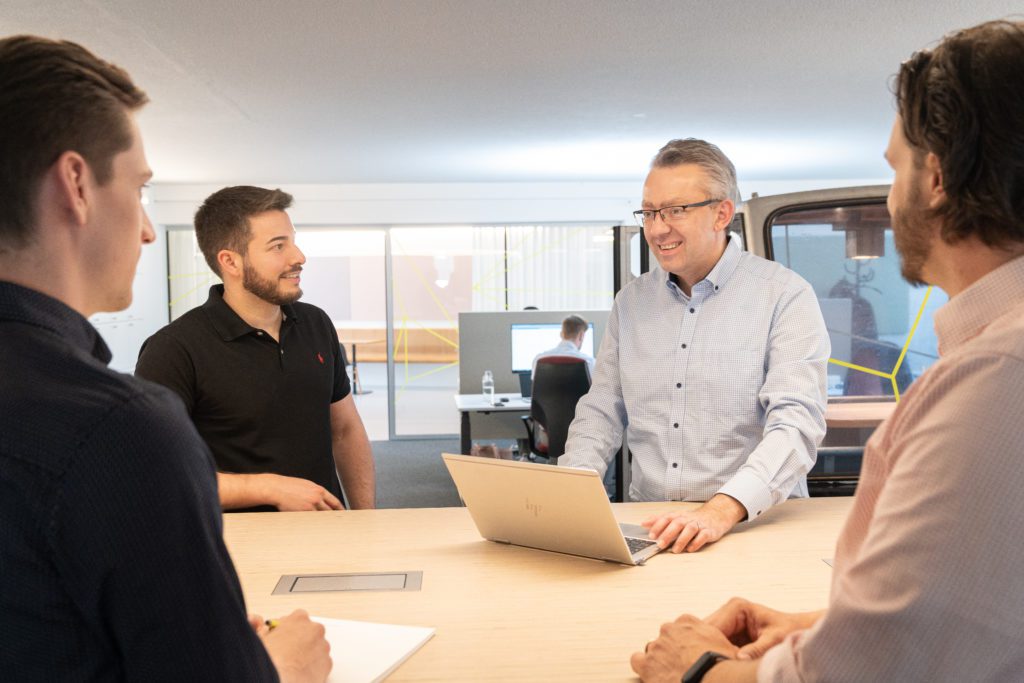
We have a service offer for you
Site assessment for your sustainable IT procurement
Sustainable IT procurement: better today than tomorrow!
The topic of sustainability has gained in importance worldwide in recent years. In the private sector, as well as at the federal, cantonal, municipal and communal levels, there is a growing expectation that sustainable aspects be taken into account in procurement. With the revision of public procurement law (revBöB/IVöB), the public sector has even been obliged to award the contract to the most advantageous offer rather than the most favorable offer. This shifts the focus away from the pure price perspective to the quality characteristics of a solution (IVÖB2019 Art. 29). The consideration of sustainability as an award criterion is now explicitly required.
Sustainability is broadly divided into three categories:
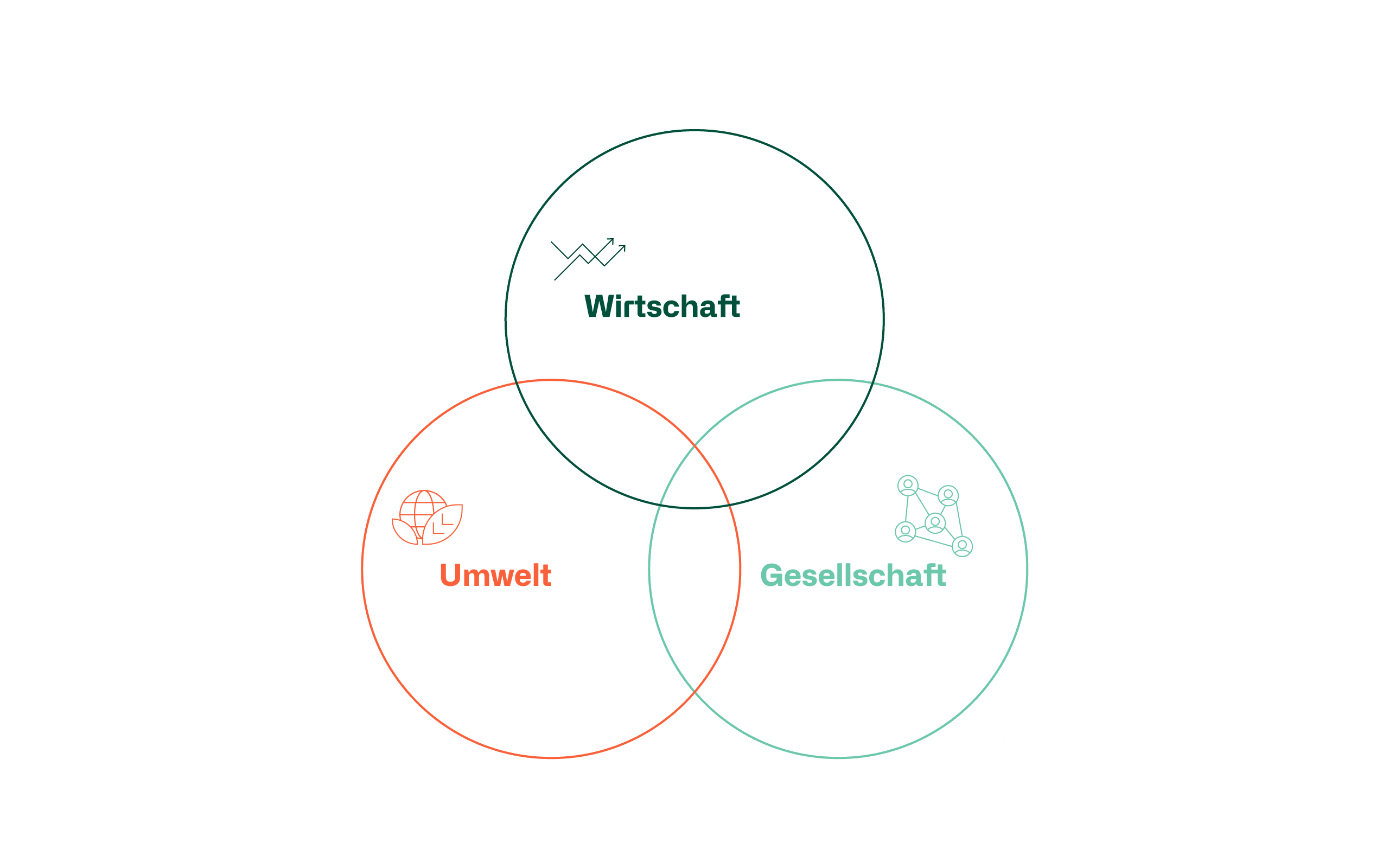
Society: Good working conditions (CLA, international standards, occupational safety, etc.)
In practice, this can mean that not only the working conditions of the direct supplier are queried. The criteria should apply to the entire supply chain and evidence of this should be requested.
Economy: Consideration of costs over the entire life cycle and economic significance
In practice, this can mean that not only the initial acquisition costs of a service are evaluated, but also the costs of the entire service life, the so-called TCO (Total Cost of Owership).
Environment: energy and resource efficiency, recycling possibilities/packaging, optimal period of use
In practice, this can mean that explicit maximum values for electricity or refrigeration consumption are specified and that underconsumption receives additional points in the evaluation.
Sustainability certifications
In order to avoid having to define and specify the individual social, economic and environmental criteria yourself, various labels have been established in recent years. However, it takes some time and experience to be able to correctly classify the quality of information and the degree of coverage of your own requirements. atrete can help you find the label that fits your strategy.
As examples, two labels known in the market are briefly explained below.
TCO Certified
This certificate was founded in 1992 and at the time of writing is in generation 9. It is the most widely used label in the world and is applied by almost all manufacturers in the IT industry for notebooks, monitors, projectors, servers, storage, network and smartphones. TCO Certified meets the requirements of ISO 14024 Ecolabel Type 1. https://www. Topten.ch displays the TCO certificates for various products, including IT, including the version and certificate number. It is important to specify clearly in the tender which version of the TCO certificate the product to be offered should have. It is also possible to search for products on the https://tcocertified.com/de/product-finder/ website. However, the data basis is less well-founded than on Topten.ch.
Blue Angel
This certificate was founded in 1978. It is a German label and widespread in Europe, covering more than 20,000 products and services from over 1,600 companies. The IT related product groups include computers, monitors, printers, servers and storage. In addition, software is also certified. The seal for software states that the software is optimally coordinated with the underlying hardware, with a lower utilization of the components. As a result, less power is consumed and this extends the life cycle of the hardware. The Blue Angel label also meets the requirements of ISO 14024 eco-label type 1. Products can be searched for on the website https://www.blauer-engel.de/de/produkte via a category directory. However, the database basis is not comparable with TCO Certified or Topten.ch in terms of the number of products covered.
Practical case with the sustainability criteria society, economy and environment
atrete accompanied a client in whose tender smartphones were procured.
One sustainability requirement was that the repair had to be done in Switzerland and that the majority of the parts could be reused.
Criterion Society: This means that jobs are provided in Switzerland and that it is ensured that the working conditions applicable here are observed in the repair process.
Criterion Economy: The supply chain in Switzerland for the repair process as well as the repair itself secures people an income and employment. The integration of the second labor market is conceivable.
Environmental criterion: Local processing means that the CO2 balance for transporting a faulty device is better than if it is taken abroad. It was also defined that the battery must be replaceable in order to conserve resources.
Recognizing the customer need for a local repair service, many manufacturers have strengthened national support organizations or formed domestic partnerships in recent months.
Another trend is that the customer is becoming more and more involved in the repair process. With intelligent apps and simpler construction methods or easier access to the individual components, repairs can be carried out by the customer himself.
Our assessment
Sustainability in IT procurement is becoming increasingly important. Where possible, IT should apply the company's existing sustainability guidelines to procurement. Here it is important to find out which goals can be supported by IT and where it may be necessary to deliberately distance oneself. If this is the case, proactive communication internally and possibly externally is important in order to strengthen the reputation of the company's sustainability strategy. atrete provides support here in the evaluation of the individual case with suitable methods. Sustainable procurement can cause additional costs, but this can be counteracted through innovation (functional tendering), quantity bundling and a cost consideration over the entire service life.
Sustainability does not always have to mean additional costs. On the contrary, sustainability can even have a positive impact on price through innovation, volume bundling and TCO considerations.
We use our many years of experience in defining sustainable procurement criteria profitably for your individual procurement. With our support, you can master the new requirements and set the right cornerstones for sustainable procurement in IT.
atrete's team continues to grow
The IT consulting company atrete continues to grow. In the last two months, two new colleagues have joined the atrete team to strengthen the areas of Cloud and IT Sourcing Advisory.


Moritz Kuhnjoined atrete on 1 December 2021 as a consultant in the cloud practice area. Previously, he worked for several years as a system engineer at a cloud service provider. His main activities consisted of the development and implementation of new services and automations as well as the onboarding of new customers. In addition to his degree in computer science, Moritz Kuhn holds certifications in Microsoft Azure and ITIL. He is currently in the final semester of his Bachelor of Science FH in Business Informatics.
Christian Klein has been working as a Senior Consultant in the IT sourcing advisory practice area at atrete since 17 January 2022. Over the past 20 years, Mr Klein has held various positions in data centres on the customer, manufacturer and service provider side. In the last seven years, he acted as a strategic IT sourcer in retail and insurance. He actively accompanied the sourcing department and GroupIT of the largest retailer in Switzerland on the digital transformation as IT Sourcer and Scrum Master SAFe®. As an IT generalist, he also has many years of diversified experience in the development and optimisation of sourcing departments and their processes. He holds an MAS in Customer Relationship Management and a Federal Diploma in Computer Science. He also holds numerous other certifications, including in Lean-Agile Procurement and SAM (Software Asset Management).
Success factors for multi-provider sourcing
A multi-provider approach is the rule rather than the exception in today's agile environment. This blog looks at the factors for a successful multi-provider approach from a procurement and operations perspective and concludes with five golden rules.
Why multiproviders at all?
Doesn't it make more sense to source everything from a single source, i.e. classic one-stop shopping? The times when a company was a classic "IBM/HP/Cisco/Microsoft/..." shop" are long gone. Today, to put it bluntly, the IT departments have lost control of IT to a greater or lesser extent due to the various cloud services. The business units set the pace and the IT departments see themselves in the role of "integrators" of the various services they receive. Of course, the business units expect their applications to run smoothly and efficiently and - Log4J says hello - security to be guaranteed at all times.
What does this mean for IT departments? Differentiation according to the size of the company is a good idea. For (MSEs) it can make sense to rely on only one provider. As a rule, however, the core applications (be it a dispatch system for a courier service provider or a billing system for a law firm) are delivered by the specialist and usually also maintained. It is conceivable that a single external provider takes the lead here and coordinates all other providers in the sense and on behalf of the SME.
For larger MUs and large enterprises, on the other hand, a multi-provider approach is likely to be the norm, starting with the internet provider, through public cloud services such as mail and voice, to the procurement of server and storage services, virtually all companies today are confronted with a multi-provider environment. The big IT providers will try to refute this argument: Their offerings are global and provide the full range of IT services: from the data centre to networks to applications and the SOC. Such an approach can certainly be attractive and mitigate part of the multi-provider issue, but it presupposes that the IT department also has a 'global reach' and can meet providers of this size on an equal footing. Otherwise, caution is called for here: the willingness of the providers to engage with the needs of the demanding IT departments decreases as the size of the provider increases. This is not due to an inability or "bad will", but simply the compulsion of the large providers to use the "economies of scale".
Procurement and lots
So what to do? For now, let's turn to the question of procurement of IT services. The triggering point for procurement can be of various kinds: technology change, end of support, end of contract, cost pressure, public procurement law and others. It therefore coincides only coincidentally with an internal discussion about the sourcing strategy and thus the right mix of IT providers. Of course, it would be elegant if the IT and purchasing departments had a joint, medium-term plan in mind according to which the various IT services are procured. In this way, the multi-provider strategy could not only be defined, but also implemented. Ideally, the duration of the individual contracts would be synchronised or at least coordinated.
However, since this is usually not the case, it is advisable to ask the question about the envisaged provider strategy for upcoming larger procurement projects. The concrete question in this regard is the question of lot formation. Often, the lot formation is made according to purchasing aspects, with the understandable thought that large lots can lead to lower prices. However, this consideration alone does not go far enough. In fact, the multiprovider strategy is determined by the lots. Somewhat simplified and reflected in the generic IT stack, it is therefore necessary to determine which elements are to be procured jointly, i.e. as an integral lot, and which as an individual lot.
The graphic below can be used to launch the discussion. There will probably not be a unanimous opinion on the correct lot formation, but consensus building as such is already helpful: Here, the crucial questions are brought to the table from the diverse perspectives of the participants and mutual understanding for the respective positions is created.
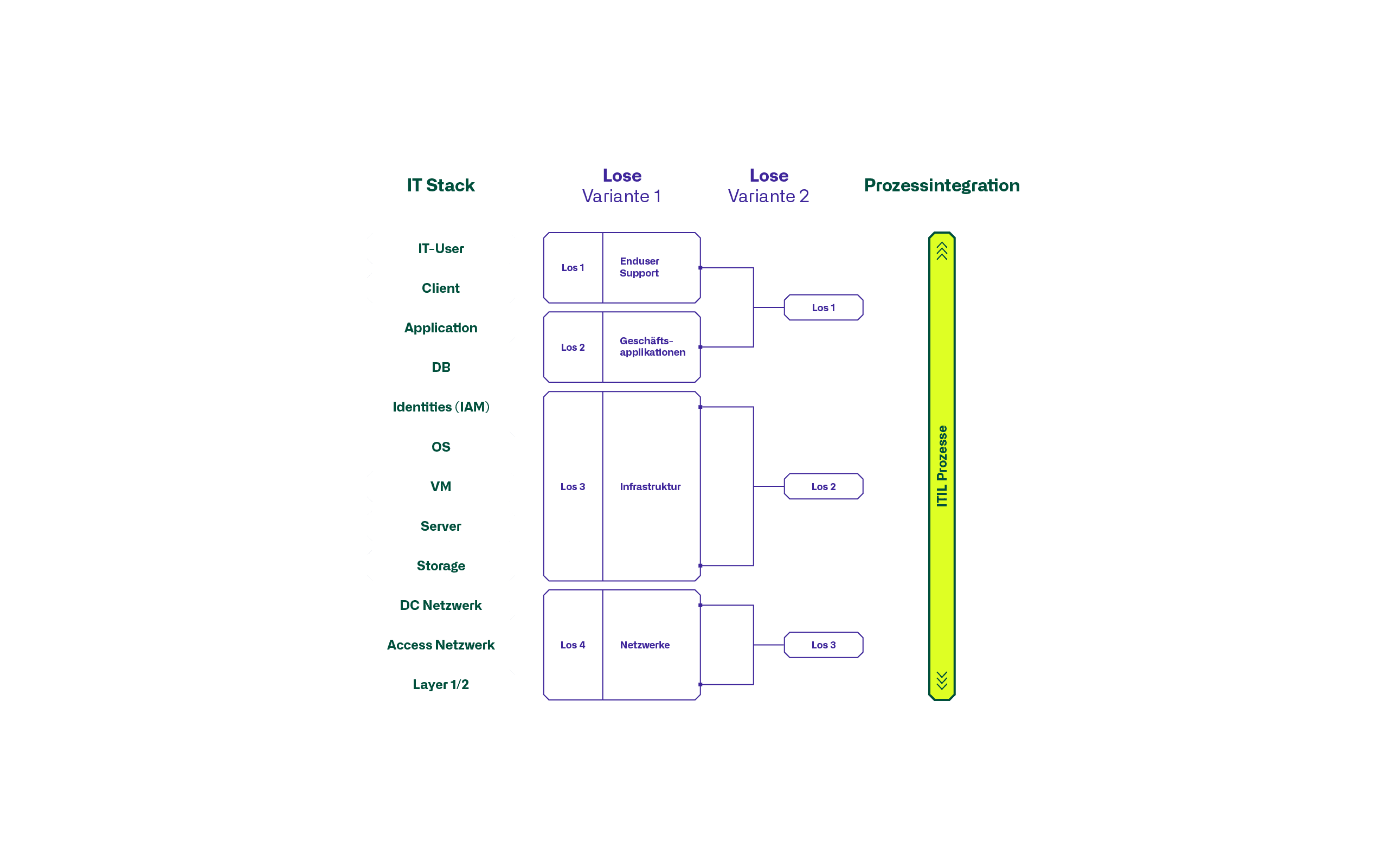
It is quite obvious that the question of lot formation cannot be solved independently of the multi-provider strategy. Rather, the latter is determined by it. Two alternatives are shown above as examples, one for a 4-provider strategy and one for a 3-provider strategy.
The crux of the decision regarding the lots is not so much the actual procurement as a one-off matter, i.e. RFP with specifications, evaluation and award of contract, but rather the subsequent operational phase, which will last for years. During the operational phase, it will become clear whether the lots were chosen in such a way that the providers and the internal IT can function successfully together.

IT sourcing advisory
Would you like to learn more about procurement with atrete?
Read more here
Process integration
This addresses process integration. As shown above, it is imperative that the ITIL processes function across the entire IT stack. It must be obvious that a larger number of involved providers also require more process coordination. Just take the example of the incident management process. The first question is who is responsible for incident management. The simple answer to this is that each provider must of course take responsibility for its services. Sounds plausible, but in practice it is not, because in the classic case the fault is always assumed to be with the other provider, thus starting the well-known back and forth of ticket assignments. Direct, straightforward troubleshooting, as envisaged by the ITIL textbook, is likely to be the exception.
Well, how can this be remedied? Since the problem is multi-layered, it is also worthwhile to act on different levels. We see three levels of action: one of the soft skills type, one technical and one formal:
- Soft skills: transparency through communication, learning and continuous training
- Technique: E-bonding[1]
- Formal: Service Level Agreements (SLAs)
Creating transparency means showing the rough connections and making them known to all those involved, i.e. the external providers as well as the internal IT departments. The primary objective is to create clarity about responsibilities during and after the procurement phase. We are not talking about multi-page workflow presentations here, but about overviews that offer the various support units - each at their own level - an orientation in the provider landscape. Once implemented, this will probably become superfluous, because the teams involved will establish a working mode as experts in their fields. It is important to continuously improve this working mode through periodic exchange of experiences, FAQs, documentation of known errors and their workarounds as well as the deposit of knowledge base articles in the relevant ITSM tools. This may already be common practice in many companies today and not worth mentioning per se. The important point is that this common practice actually applies to every single provider. Whether a CH, near-shore or even an off-shore provider is involved, all will be familiar with ITIL processes and will have implemented them with a top ITSM tool. In practice, however, it turns out that these are good prerequisites, but not a guarantee that the incident management process will work in the multi-provider environment discussed here! The decisive factor for success is that the learning and training of the interrelationships of the IT environment and the ongoing improvement of incident management is done from the perspective of the purchasing company! To bring this about is - and will probably remain for a while - a challenge for the internal IT departments.
E-bonding is the buzzword of the second level of action. A buzzword that typically goes down well among IT cracks and - since it is technically elegantly feasible - is associated with great expectations. Often the need for e-bonding in procurement projects is also recognised and provided for in the agreements and contracts. Experience shows, however, that it is precisely here that attention must be paid to the chosen multi-provider approach. Who is the master? The ticketing tool of the largest provider or that of the company? Who sets the designations, the support groups, the priorities? If one of the big providers is in play, it might be difficult to override their standards. In a relationship of equals, on the other hand, it is easier to enforce internal ideas. Whatever the size of the relationship, it is essential that the internal process owners have their say in the matter. And it is equally clear that the internal IT architects must be on board with the design, because the technical implementation is usually more complex, more expensive and more time-consuming than is assumed in the course of and under the time pressure of the procurement.
The enticing thing about e-bonding - and this is also the reason why it should not be abandoned without necessity - is the company's ability to be close to the basis of reporting. Knowing whether and how the agreed services - i.e. the service levels - are being delivered by the various providers is match-critical, because knowledge is power - or more simply, knowing whether the SLAs are being met is the basis of the relationship with the providers. This brings us to the next level of action, the formal SLAs.
This third, formal level is about contractually securing the service levels, i.e. the SLAs. We deliberately mention this level only as the third, because in a certain sense it represents the fall-back level. Because it is possible - and often the case - that the SLAs are defined by all the rules of the art. Key performance indicators (KPIs) are precisely recorded and technically described in great detail, the operating hours and all other related definitions for fault reporting, ticket acceptance and what goes with it are agreed. Nevertheless, we cannot achieve certainty that the desired availabilities will be met - to stay with the example of fault clearance. The reason is simple: we can conclude SLAs with exactly one provider at a time. However, the achieved availabilities of the IT services are the result of the combined efforts of the troubleshooting across the entire provider landscape. The graphic below attempts to illustrate this.
However, this does not mean that SLAs are not important - the opposite is the case. In the multi-provider environment, coordinated SLAs are a mandatory prerequisite for achieving the service levels demanded by the business. The focus in procurement must be to contractually agree with each individual provider on the internal and thus the same operating model - starting with operating and on-call times - in the form of SLAs. The SLAs represent the common bracket of the operating model in the multi-provider environment!
In practice, the popular definition of minimum availability in the style of 99.99% cannot meet this requirement. Each provider will define these figures from his own point of view and not act from the company's point of view.
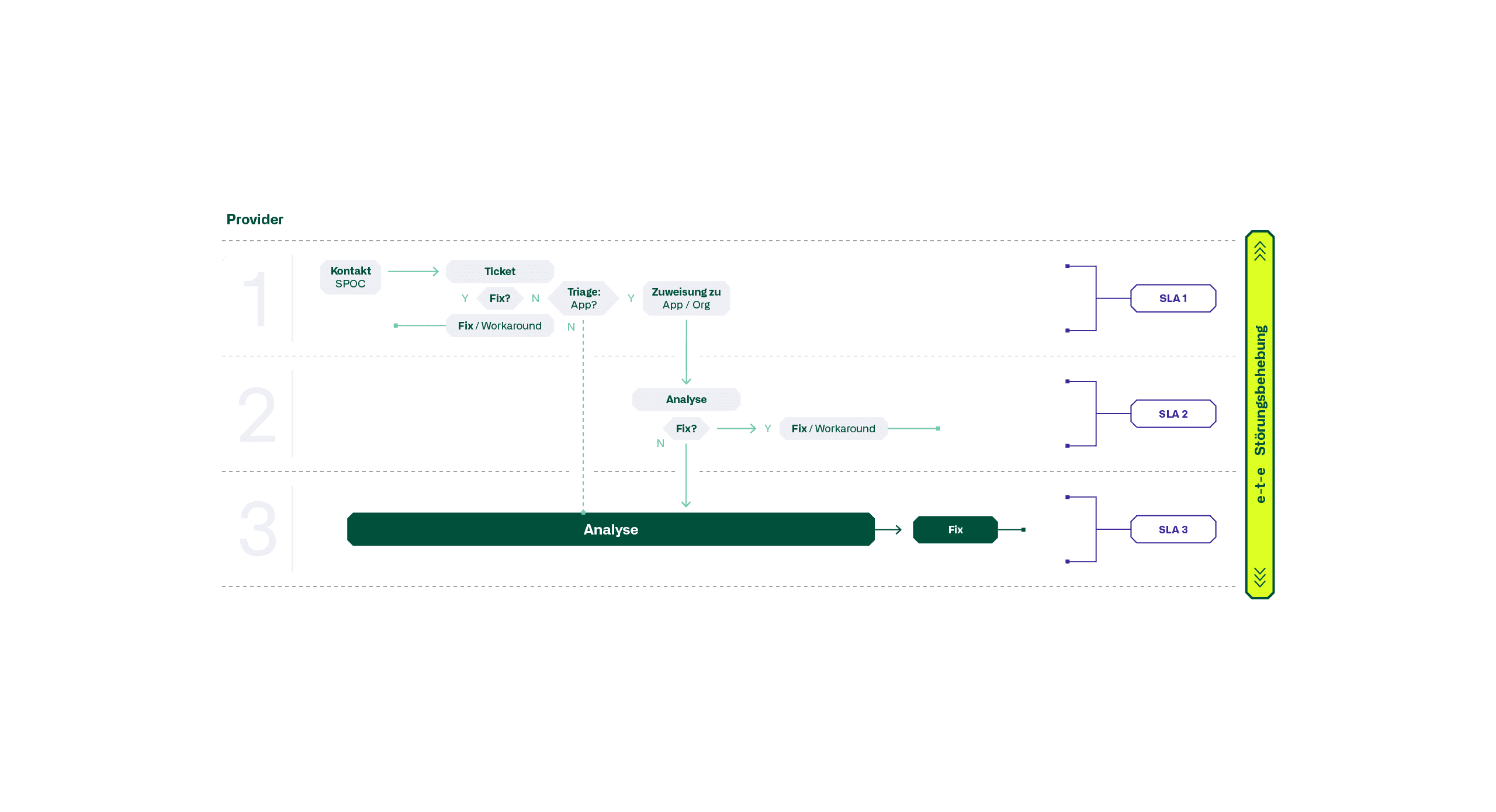
To mention it again: Smooth troubleshooting will primarily depend on the soft skills of those involved. The decisive contribution is made by the teams involved in the day-to-day business and assertive provider managers as mediators between the company and the providers. Technology (e-bonding) and formalism (SLAs) are useful "aids".
Let's turn to the "hot spot" of troubleshooting in a multi-provider environment, the service desk. We would venture to say that the service desk is THE success factor for successful troubleshooting. As the first point of contact for all messages and calls for help from IT users, this is where the decision is made as to how the troubleshooting will proceed. The first action of the service desk is triage, whether this is done by a human or - increasingly often - a robot. In the multi-provider environment discussed here, assigning the opened ticket to the correct support group is not always a simple matter. Knowledge of the entire IT landscape, the company AND the support organisation of the individual providers is required. Even more, the interrelationships of the individual IT services - i.e. the service chain - must also be known.
These are formidable requirements and the question arises whether, given the relevance of the tasks, a service desk in a multi-provider environment can be outsourced at all. Given the given importance, should this not better remain an internal function?
Practice shows that outsourcing of the service desk is prevalent, but unfortunately not always with the hoped-for success. The reason is simple: cheap offers in the near- or off-shoring sector tempt people to buy in service desk services. After all, maintaining a 24/7 support service by competent IT experts is a costly business at the local wage level. The counterpart of a 'cheap' offer is often a reduction in triage competence. Unfortunately, robots can only provide a rudimentary remedy, as these digital friends are nowadays mainly strong in solving standard cases. But standard situations are rarely the case when it comes to faults in the multi-provider environment. And if they are, they are 'known errors' and already covered by checklists or FAQs.
So how to proceed?
An interesting approach from our point of view, which we see more and more in practice, is the addition of a "1.5" level support to the classic 1st level support. In this case, a QA function is established and staffed with internal know-how carriers. As an 'inserted' QA function, this 1.5 level support monitors the correct allocation of tickets to the providers involved. Or in other words: an internal validation of the ticket queue and the allocation to the support groups is carried out by the 1st level initially. The goal: an improvement in the hit rate for faults in the multi-provider environment. A development that makes this approach additionally attractive is the current shift towards IT services from the various clouds; with the 'Journey to the Cloud', further complexity comes into play. And the preservation and maintenance of internal triage competence is gaining in importance.
Finally, a reflection on the topic of in- or outsourcing, a topic that in recent years has mostly been discussed with a preference for outsourcing. At most - more in the sense of appeasing those affected - the term 'right-sourcing' was still included. Today, the pendulum is already swinging back. We are increasingly seeing organisations that are re-sourcing important IT functions such as security. For the multi-provider issue, this means that internal departments are also to be classified as 'providers'. Sounds simple, but it is not: an SLA (external contractual obligation) is easier to claim than an OLA (an internal 'agreement'). The ticket flow in the event of a malfunction must also be regulated in detail again. Both in terms of the SLA-relevant times and the technology - the keyword e-bonding should be mentioned again here.
The fact is that sourcing strategy is not a one-way street towards out-sourcing and that the multi-provider theme is likely to gain importance through selective in-sourcing. Let's summarise the five golden rules:
The 5 golden rules
- Multiprovider decision
Don't let your provider landscape be a product of coincidences. Remain the driving force of your multi-provider approach and not the trigger points for IT procurements that arise rather randomly! - Process integration
Try to focus on the IT processes across all involved providers from the beginning and act on several levels for process integration: Soft skills - Technology - SLAs - SLAs
Understand the SLAs as a 'bracket' of your operating model. Standardise the SLAs company-wide and demand them from the providers. - Service Desk
The Service Desk is the business card of the IT department and the key to functioning troubleshooting. Adding a QA layer in the sense of 1.5 level support at triage is an alternative worth considering. - In-versus outsourcing
You should 'think' about in-sourcing when making these considerations. With in-sourcing, internal departments become providers. And your multi-provider landscape becomes even more diverse - SLAs become OLAs.
Theory and the knowledge of how things should be is one thing - the other is the experience needed to make multi-provider sourcing a success. atrete has been active in this environment for more than 20 years and has been able to build up broad-based know-how. We advise and accompany sourcing mandates throughout the entire sourcing cycle.
[1] E-bonding is a concept for directly linking the customer's ITSM systems with those of their service partners via a digital interface. The transmission of incident tickets, change or service requests by telephone or mail and the associated multiple entries are no longer necessary.
Efficiency gain through digitalisation in the evaluation process
With a cloud application developed specifically for our day-to-day advisory work, we now carry out the evaluation process even more efficiently together with our clients online, process-guided and fully documented.
Evaluating a tender with the help of a spreadsheet programme is probably still the "quasi-standard" for the vast majority of specialists involved in procurement. However, the advantages of almost infinite flexibility (= error-proneness!) and diverse design options (= time-consuming!) of the beloved and hated spreadsheet are increasingly competing with the requirements for online and multi-user capability, process management and traceability. A change is therefore imperative.
atrete therefore decided to have its own cloud-based solution developed, which meets the specific requirements of our Sourcing Advisory mandates in a tailor-made manner. The result is inspiring!
Basic principles of a structured evaluation
When evaluating products or services, it is often difficult to make decisions regarding the choice of a particular offer that are based on objective, comprehensible and not on preconceived, subjective arguments. The current public discussion about the procurement of new fighter aircraft for Switzerland shows once again how many "specialists" try to overturn the result of a thoroughly systematic evaluation process[1] with more or less solid arguments after the type decision announced by the Federal Council.
But even in many an IT sourcing project, heated discussions are held sooner or later regarding the procedure and the choice and weighting of suitable selection criteria. In the case of controversial requirements, often another line is simply added to the supplier's questionnaire (Excel is ideally suited for this!), without thinking in advance about how the answer to this question should finally flow into the evaluation of the offer. Without a guided process, this results in questionnaires with hundreds of entries, where the evaluation team is overwhelmed with the sheer amount of information after receiving the offers.
In order to accompany our clients through this process in a structured manner and without emotion, atrete has for many years relied on a methodical approach based on the principle of utility value analysis.
The concrete application is usually as follows:

- In a joint workshop with the evaluation team, all criteria are first recorded that are related to the requirements of the product to be evaluated. These criteria are to be divided into "must" and "can" criteria. The "can" criteria, usually also referred to as evaluation criteria or award criteria, are then grouped into categories (e.g. technical parameters, operational criteria, service offer, qualification of supplier or manufacturer as well as costs and investment protection). Depending on the complexity, the use of corresponding sub-categories may be necessary.
By means of a pairwise comparison among the main criteria, the weighting of these categories should be determined in order to express their relative importance. The evaluation criteria summarised in each sub-category are also given weights (by pairwise comparison or by directly assigning the weights). This step is also preferably carried out in plenary in order to achieve the highest possible acceptance of the criteria and weighting. At the same time, the evaluation grid should be agreed upon (e.g. 0 - 4, school grades, etc.). Only after this step can the tender documents be prepared and the questions to the providers be formulated in such a way that the agreed criteria can also be evaluated by the evaluation team (a question to be answered with yes/no does not allow for a differentiated evaluation, a generally formulated question, on the other hand, can make comparability between the answers impossible. The art here is to find a good middle ground in the formulation). - After receipt of the offers, the members of the evaluation team evaluate each individual evaluation criterion on the basis of the agreed evaluation grid. Subsequently, the submitted evaluations are compared and any deviations are again clarified in the plenum in order to achieve a uniform evaluation(consolidation). If there are still unanswered questions about the evaluation of individual criteria after the first consolidation, these are to be clarified through queries to the providers, reference calls or even tests.
- The utility value of each evaluation criterion is now determined for each offer by multiplying the weighting with the respective evaluation and finally calculating the total utility value by summation. The offer with the highest total utility value therefore best fulfils the given criteria and should therefore be ranked first.[2].
So much for the theoretical background. On the web you can find many interesting articles on the topic of utility analysis and pairwise comparison, as well as on other evaluation methods, and in some cases also critical discussions of the topic. In our 25 years of practice, the procedure described above has proven itself in principle, but must also be adapted to the project situation.
The beginnings on the basis of MS Excel
I can still remember my colleague at the time, Roland Henzi, who mapped the method in a Microsoft Excel template more than 25 years ago in order to be able to systematically compare and evaluate several offers for a network hardware procurement. In the years that followed, we used this template dozens of times in the context of our mandates, each time adapting it to the specific project requirements and successively adding further auxiliary tables for the evaluation as well as corresponding evaluation graphics.
As easy as it is to use an Excel-based assessment, the challenges are:
- in step 1) and 2) the "ad-hoc" moving of an assessment criterion from one main category to another (cut & paste leaves an empty line or messes up the order and weighting at the inserted place),
- at step 3) in the merging of individual assessments and the associated handling of different file versions, and
- in general, the increasing restrictions on the customer side regarding the exchange of data or restrictions on access to a common data repository.
In addition, our larger clients are increasingly using online tendering tools, which, after thorough examination, are not suitable for everyday consultancy work, however, as the range of functions is usually far too extensive (claim to be able to cover the entire procurement lifecycle) and for licensing reasons.
atrete Eval-Tool goes online
Commercially available tendering or procurement tools were therefore not an option for us, as we were looking for an easy-to-use tool with a focus on the evaluation process.
For lack of alternatives, after some deliberation we entrusted one of our consultants with software development experience with the creation of a prototype. Barely two weeks after the start, we were already able to marvel at a first graphical implementation for step 1) and have the diverse possibilities of modern open source software modules explained to us - provided one is familiar with the suitable software modules. Unfortunately, the project took a back seat due to the prioritisation of client mandates and we decided to enter into a cooperation with Swiss Knowledge Base AG for further development.
A few sprints later, we now have an easy-to-use, web-based solution that allows us to work even more efficiently in our sourcing mandates. The times of sending Excel versions to all evaluation team members by e-mail are over, an evaluation of bids can take place independent of time and place and, of course, the traceability of actions and compliance with data protection is guaranteed.
The atrete evaluation tool fully supports steps 1) to 3) above:
- Breakdown into "mandatory criteria" (suitability criteria or technical specifications) and evaluation or award criteria
- Recording of evaluation criteria and flexible categorisation over several hierarchies (shifting by mouse click)
- Comment field for entering scoring specifications per criterion (when does the answer get the maximum score etc.)
- Weighting of evaluation criteria both via pairwise comparison and by directly entering the weighting
- Use of predefined grading scale or recording of project-specific grading scale
- Definition of price valuation
- User capture of the evaluation team
- Individual evaluation of the bids received incl. comment function by members of the evaluation team
- Consolidation function of the individual assessments
- Export function (criteria, ratings and comments) for further use in reports, management presentations or provider de-briefings
- Versioning (criteria, weighting, evaluations)
- Transfer of an existing catalogue of criteria into a new project
- etc.
Conclusion
We have already been able to successfully use our new evaluation tool in initial customer projects and have learned to appreciate the benefits of digitalisation:
- Efficiency through "real collaboration" instead of individually in Excel
- Focus on the really decisive factors
- Historisation / traceability of the inputs
Only time will tell whether we will continue to develop the tool as an independent software and market it in the future. In any case, with our own development we were able to take an important step towards digital counselling.
My team and I are looking forward to supporting you in your next evaluation project with our new digital "little helper". You can count on our experience from more than 120 completed tenders in various areas of IT.
[1] See brief report Evaluation New Fighter Aircraft, https://www.newsd.admin.ch/newsd/message/attachments/67477.pdf
[2] If the utility values are close to each other, it is recommended to carry out a sensitivity analysis. In the case of procurements under private law, if the outcome is close, further evaluation criteria can be added, the evaluation scale can be refined or a risk analysis can be carried out. In the case of public law procurements, however, the room for manoeuvre is severely limited and it is primarily the evaluations that can be reviewed.
atrete IT consultants continues to grow
The IT consulting company atrete strengthens its team in the areas CIO advisory with Sven Matheja and IT sourcing advisory with Rüdiger Vietze.


Sven Matheja has been working as a senior consultant at atrete since 01.11.2020. He has many years of experience in global product launches and project implementations in international companies. Prior to atrete, he worked for several years at General Electric as Product Manager in the Unified Communications division. He holds a university of applied sciences degree in International Management.
Rüdiger Vietze has been working as a senior consultant at atrete since 01.12.2020. He holds a university diploma in mathematics, a Certificate of Advanced Studies in process management, and numerous other certifications, including in project management. In the past ten years, Mr. Vietze has been active as an expert for public procurement, including unusual delivery objects, and as a project manager with a focus on school IT. As a generalist, he also has many years of diversified experience in business analysis and project management.
"We are delighted to further strengthen the CIO advisory and IT sourcing advisory divisions with the two new consultants to meet the increased demand from clients."
Michael Kaufmann, CEO and Managing Partner